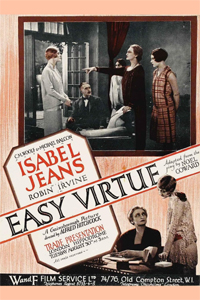“Easy Virtue” (1928), the sixth among Alfred Hitchcock’s preserved silent films, today plays like a symphony orchestra performance accompanied by moving images. As with most silents released on home video, the composer is not credited, but he or she does incredible work matching and enhancing the moods of a story that’s more relaxed and less suspense-laden than Hitch’s norm.
I’d go so far as to say this unnamed composer for the 1999 DVD release (where it’s packaged with “Blackmail”) saves “Easy Virtue.” Through no fault of the filmmakers (and I’m not punishing the film for this in my rating), this happens to be the least-well preserved of the “Save the Hitchcock 9” project, and the performances and story beats are not big enough to shine through the gloomy presentation quality.
Based on a Noel Coward play and adapted by Hitchcock regular Eliot Stannard, “Easy Virtue” explores what is now a time capsule of history. Socialite Larita (Isabel Jeans) is hampered with a soiled reputation because she wants to get a divorce.

“Easy Virtue” (1928)
Director: Alfred Hitchcock
Writers: Noël Coward (play), Eliot Stannard (scenario)
Stars: Isabel Jeans, Franklin Dyall, Robin Irvine
Famous for being famous
The idea of people being “famous for being famous” is a 21st century phenomenon (see Kim Kardashian), but Larita is a close 1920s U.K. equivalent because she’s famous for her divorce case. The film sympathizes with her, establishing that husband Aubrey (Franklin Dyall) physically beats her.
Artist Claude (Eric Bransby Williams), commissioned to do her portrait, wishes Larita would leave her husband for him, and we see from her expression she wishes she could. After a confusingly staged showdown sequence between the two men, Larita seeks a divorce from Aubrey.
Apparently being critical of the legal difficulty of getting divorced, Hitchcock shows the judge as particularly foreboding, and the gallery filled with looky-loos delighting in the spectacle of Larita’s personal nightmare.
Unlike some socialites, Larita prefers privacy to celebrity. (It’s never quite clear why she is a celebrity; the film seems to suggest that being attractive is enough.) The bulk of “Easy Virtue” explores her attempt to start a new low-key life with John (Robin Irvine), who ironically bruises her with an errant tennis ball in their meet-cute.
Jeans’ performance is subtler than most of Hitchcock’s silent stars, and if not for the orchestration, this might be a boring film because of that. Larita is not detestable, but nor is she all that sympathetic. Sure, we can see how the tabloid attention would be annoying, but her life is not bad. She lives in pure leisure at the pleasure of whatever man has most recently fallen for her.
Object as the subject
There’s something to be said here about how Larita, the story’s subject, can’t break free of being an object due to her beauty. But really … “Boo-hoo.” This ain’t exactly the most heart-wrenching problem. Plus, it’s a fairly common cinematic POV, even within the “genre” of Hitchcock, where he often gazes at the “Hitchcock blonde” yet sneakily makes her a three-dimensional character.

A lot of Hitch’s silent films benefit from the format, but “Easy Virtue” is hampered as we’re told a lot of information without emotionally absorbing it, except in the broadest sense with the music emphasizing the mood.
For instance, John’s mom (“Downhill’s” Violet Farebrother) believes he should’ve married longtime friend Sarah (Enid Stamp-Taylor). The mom openly hates Larita’s guts for not being Sarah. This is respectable storytelling in the sense that it’s clearly communicated and it makes it clear Larita is the sympathetic protagonist, but it’s likewise blunt and shallow. We never see why John loves Larita (Is he confusing a crush with love?), but also never see why Sarah is a better match. Sarah and John never get a one-on-one scene.
“Easy Virtue” starts with a confusing definition of the title phrase, then ends with a great line wherein Larita likens the tabloid cameras to guns, saying go ahead and shoot because there’s nothing left to kill. While the theme – that some aspects of celebrity life are ridiculous and awful – is well-taken, the film doesn’t get into the emotional swings it could have. (Perhaps the 2008 adaptation does better at this. I’ll watch it at some point and find out.)
On the other hand, the simplicity of Larita’s plight allows the music to shine. The composer may never get credit, but the score is the reason “Easy Virtue” is easy to watch.
RFMC’s Alfred Hitchcock series reviews works by the Master of Suspense, plus remakes and source material. Click here to visit our Hitchcock Zone.

